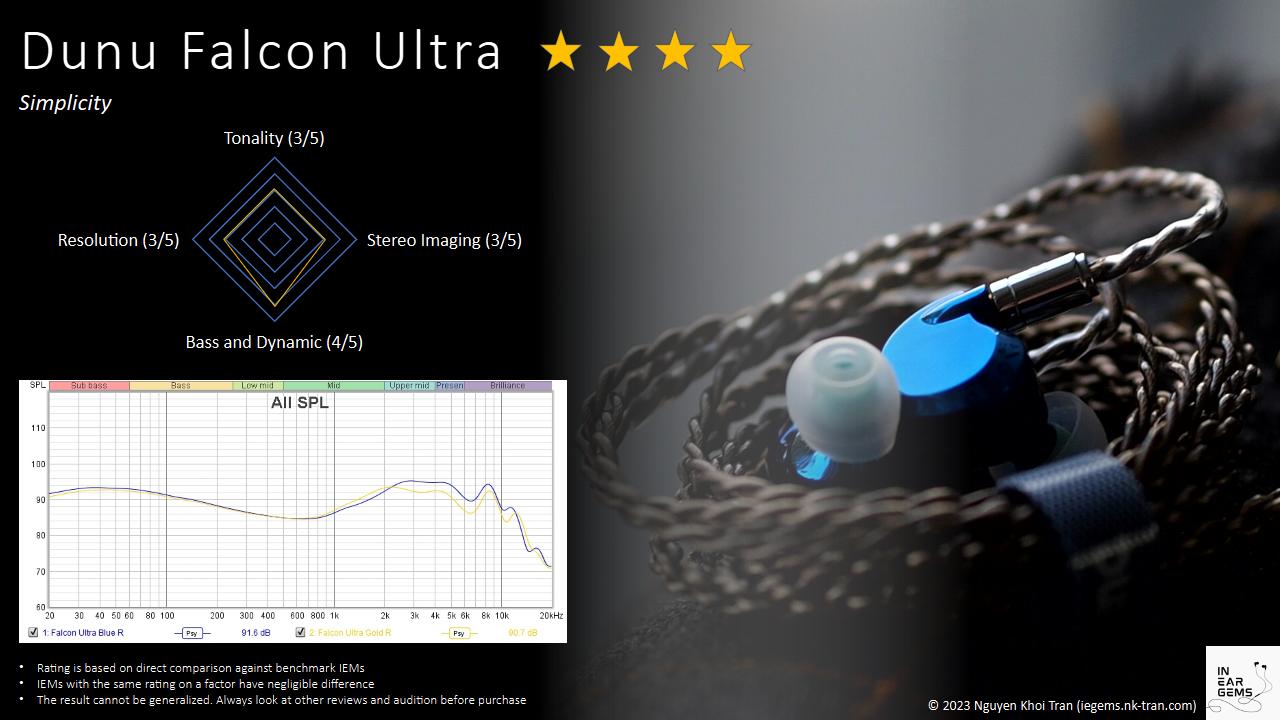Dunu Falcon Ultra - ECLIPSE for the mass
There is inherent beauty in simplicity. In the world of In-ear Monitors (IEM), nothing is more simple and, arguably, more elegant than a single dynamic driver (DD) design. One driver, front vents, back vents, foams and filters. That’s all it takes for a master tuner to make something magical.
At least, that’s the romantic vision. The reality is often disappointing. How does the latest single DD IEM from Dunu, equipped with the acclaimed ECLIPSE driver technology, translate the lofty vision of simplicity to the reality? Let’s find out.

Forewords
- What I look for in an IEM is immersion. I want to feel the orchestra around me, track individual instruments, and hear all of their textures and details. I’m not picky about tonality, as long as it does not get in the way of immersion.
- I rate IEMs within with a consistent scale from 1 (poor) to 3 (Adequate) to 5 (outstanding). Ratings are assigned by A/B tests against benchmark IEMs, regardless of the retail price.
- Ranking list and measurement database are on my IEM review blog.
- Terms used in my reviews are consistent with the glossary by Headphonesty
- This review is based on a review sample from Hifigo (Thank you!). I have no affiliation with or financial interest in Dunu or Hifigo. The unit retails for $240 at the time this review was published. More info at Hifigo
Sources for listening tests:
- iBasso DX300 (for all A/B tests)
- FiiO K7
- Hidizs XO
Local FLAC files ripped from CDs or bought from Qobuz were used for most casual listening and A/B tests. My playlist for A/B tests can be found on Apple Music here.
All of my listening was done with Dunu’s Candy tips. I usually turn up the volume until the midrange is fully audible and detailed, unless a treble peak or overwhelming bass prevents me from doing so. I don’t listen loud.
Specs

- Driver: Single dynamic driver (Lithium-Magnesium Alloy pure metallic diaphragm with ECLIPSE tech)
- Connector Type: MMCX
- Impedance: 16 ohm at 1kHz
- Sensitivity: 108dB at 1kHz
Build and Comfort
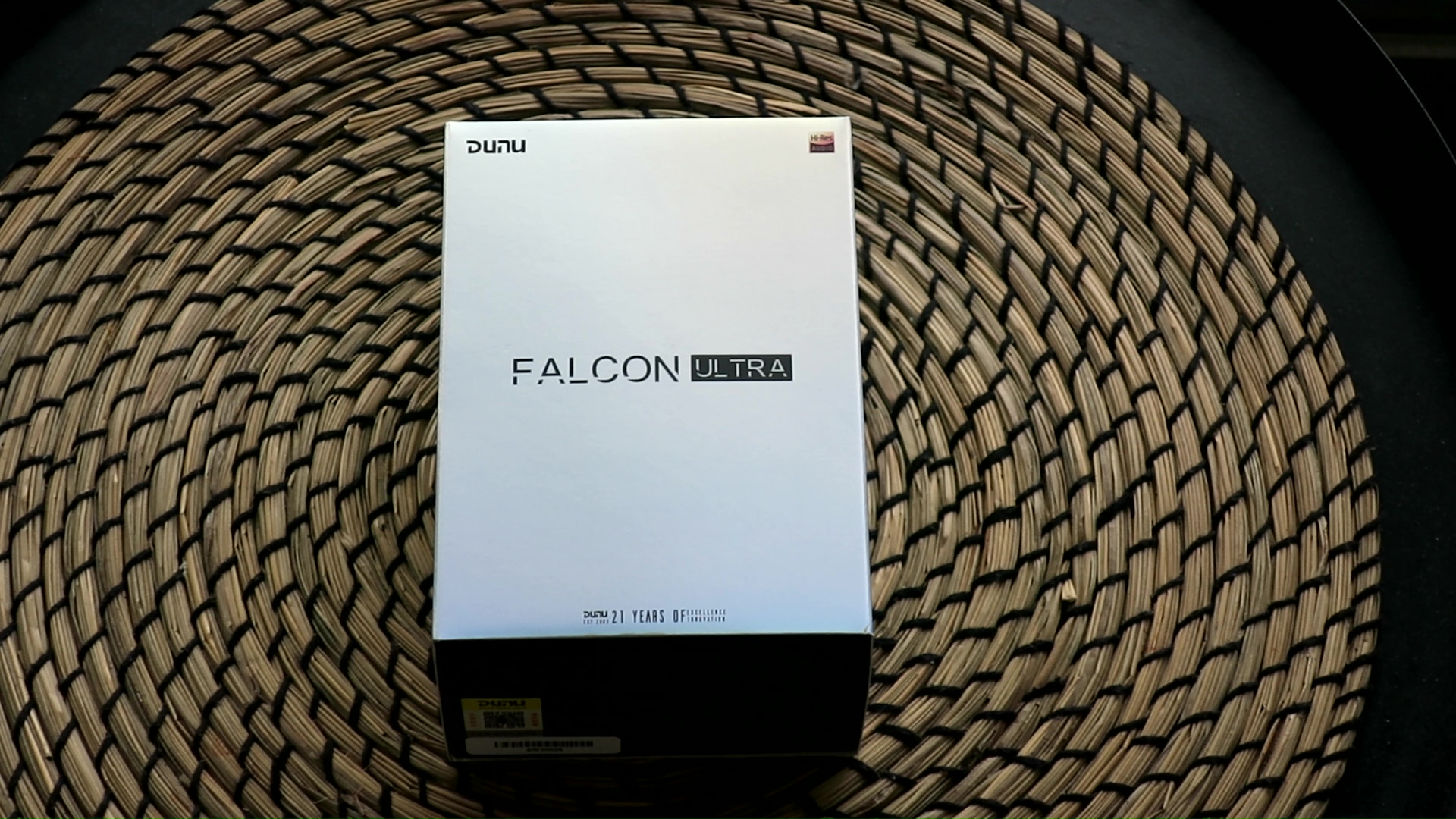


Accessories: If you have ever owned or looked at a review of a Dunu IEM, you already know what to expect when it comes to accessories: practical and abundant. Falcon Ultra comes with the carrying case that debuted recently alongside the Alpha 3 earbuds. It is roomy enough to keep the IEM comfortably, along with a few accessories, but not too large that it takes up all the space in your bag. It offers decent protection from impact. At the same time, it is soft, so it would not scratch other items in your bag.

New additions to Falcon Ultra’s accessory kit are a polished cloth and a mesh bag that helps you store the earpieces safely and avoid them banging against each other in the case. It’s clear that Dunu wants you to take good care of the Falcon Ultra earpieces. You also find in the accessory kit of Falcon Ultra the usual cleaning tool and a 3.5mm to 6.5mm adapter.
When it comes to ear tips, the Falcon Ultra arrives four options, including two proprietary types: S&S and candy. Selecting the right ear tips is a personal endeavor, dependent on both the specific IEM and individual ear anatomy. The inclusion of all four types is a thoughtful gesture, especially for those new to the IEM hobby who may not have an extensive collection of ear tips to experiment with.

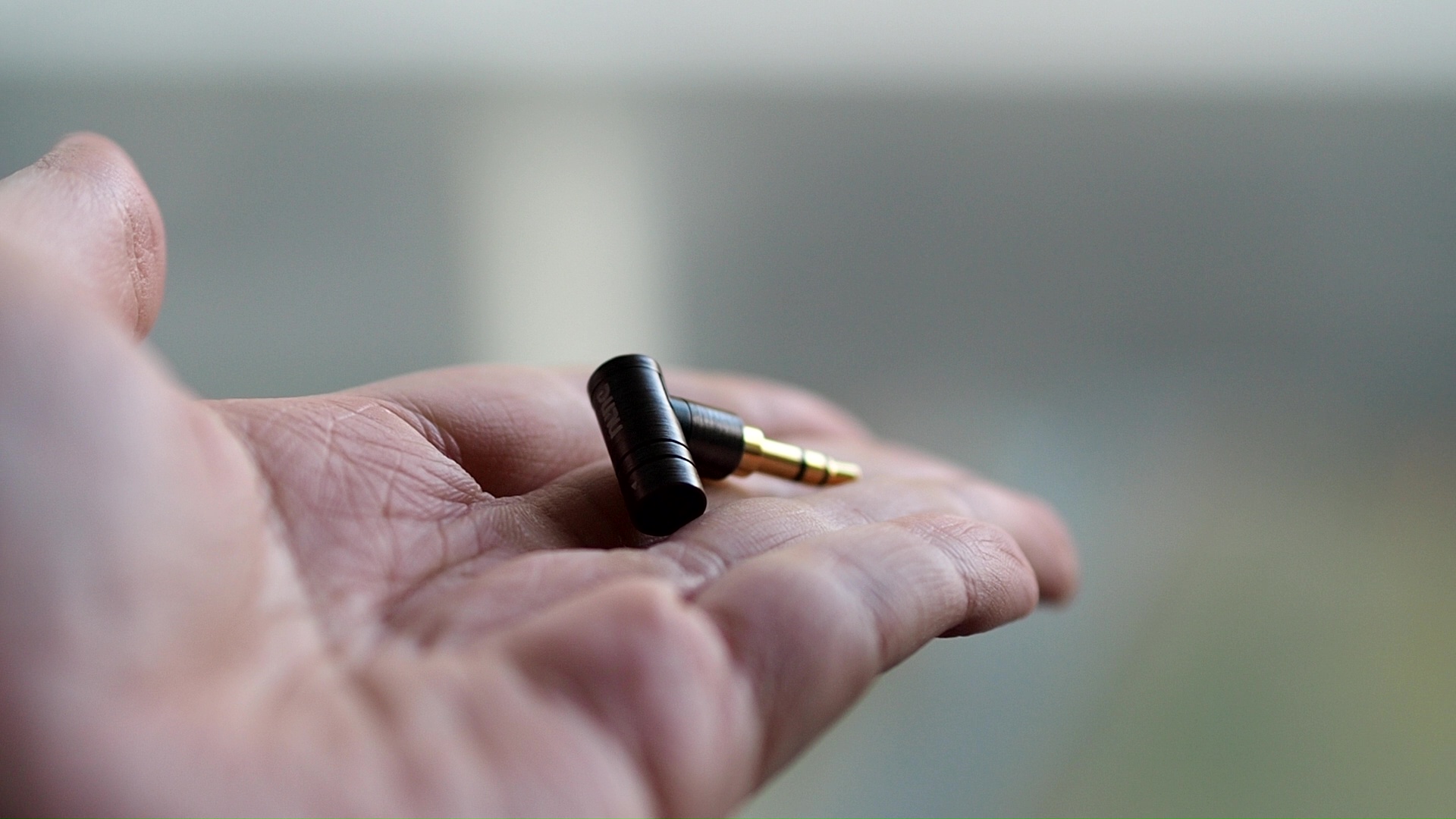
Stock cable: The Falcon Ultra comes equipped with the DUW02 Pro stock cable, sharing the same wire and braiding as Dunu’s recent Alpha 3 earbuds. As seen in my Alpha 3 review, the cable retains some memory and might coil upon itself, though this characteristic does not pose significant inconvenience during everyday use. The cable’s notable feature is the interchangeable plug system, known as Q-lock Lite, which facilitates easy switching between 3.5mm and 4.4mm connectors. Unlike the mechanical locking mechanism of the Q-lock proper system found in the SA6II, the Q-lock Lite relies on a friction fit. This friction proves robust, ensuring a secure connection throughout my testing period. The long-term durability of these connectors remains an open question, given that my personal usage rarely involves connector changes.


Earpieces: The earpieces are the stars of the show. Upon unboxing, I was struck by their compact size, which contrasts with my initial impressions garnered from online images. I had the same shock when unboxing the Zen Pro. These Dunu IEMs with ECLIPSE drivers are quite small compared to most modern multi-driver IEMs.
The earpieces are cast from stainless steel and shaped using a CNC machining process. A mirror-like finish in a vibrant blue hue catches the eye, while the textured logo texts on the faceplate’s “fringe” provide a contrasting element against the central chrome design. While the primary focus of IEMs is undoubtedly their auditory performance, I find it appreciable when manufacturers invest effort in the aesthetic appeal of their products. After all, these IEMs can be considered luxury items, and their presentation should reflect this from the moment they are unboxed.
The only downside of the metalwork of Dunu is that Falcon Ultra is a heavy IEM. Whilst Falcon Ultra is not uncomfortably heavy, the difference in weight between Falcon Ultra and a resin IEM like the ThieAudio Hype2 that I happen to have on my hand at the moment is rather comical.
Comfort and isolation: The Falcon Ultra is specifically designed for a medium fit. With a nozzle of medium diameter and length, it comfortably fits inside the ear canal, stopping just before the first bend. The overall comfort is quite good, owing to this medium fit. However, users seeking even greater comfort and a perceived larger soundstage can opt for larger ear tips and wear the IEMs shallow, sealing just outside the ear canal.
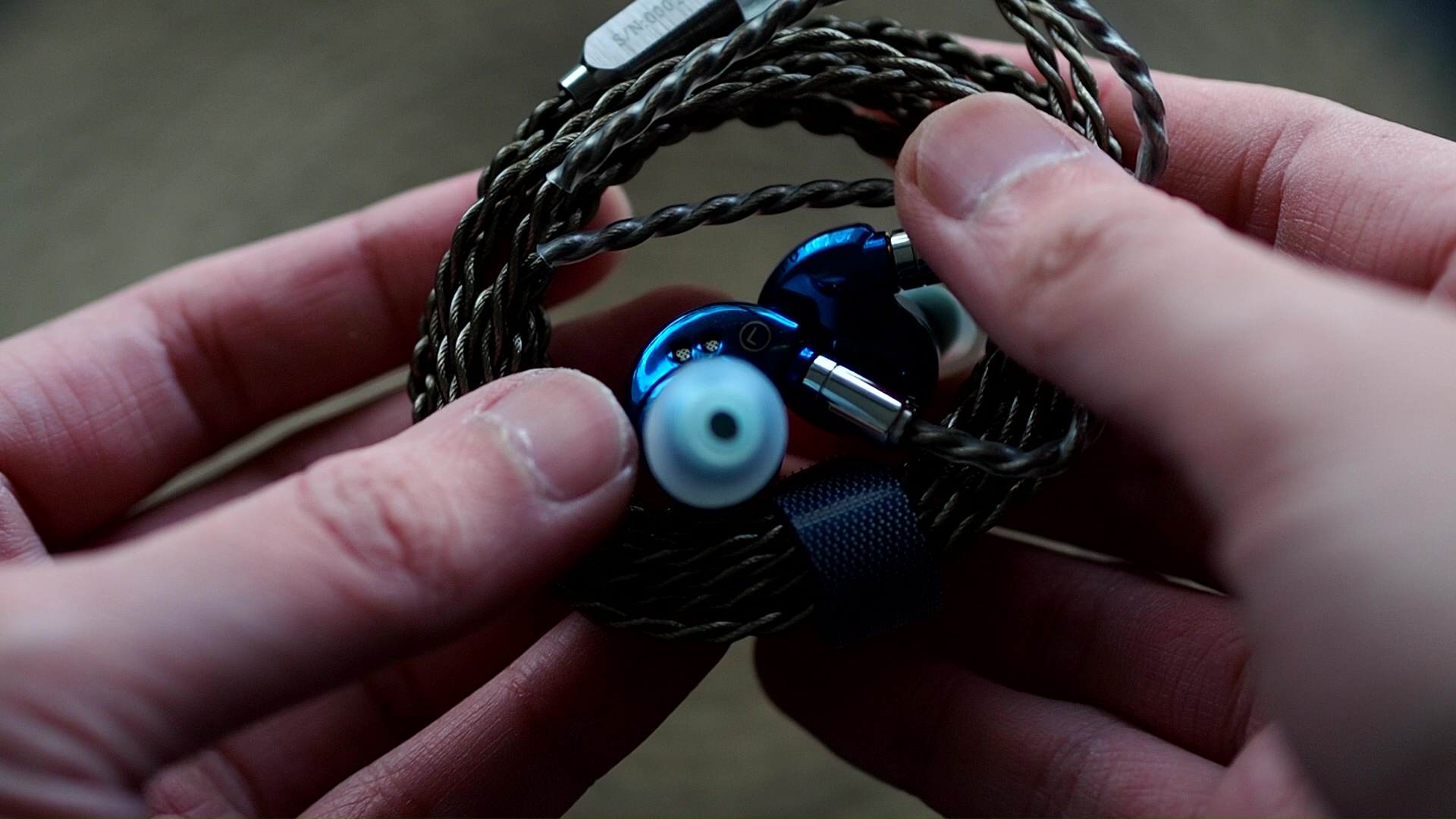
Surprisingly, despite the presence of multiple vents on the earpieces, the Falcon Ultra offers commendable isolation. When worn, it noticeably reduces street noise, providing a reasonably effective barrier. However, it’s worth noting that the deep rumble of a bus engine can still penetrate the isolation, necessitating an increase in volume to compensate for external noise.
Tonality
Frequency response of Falcon Ultra. Measurements were done with an IEC-711-compliant coupler and might only be compared with other measurements from this same coupler. Visit my graph database for more comparisons.
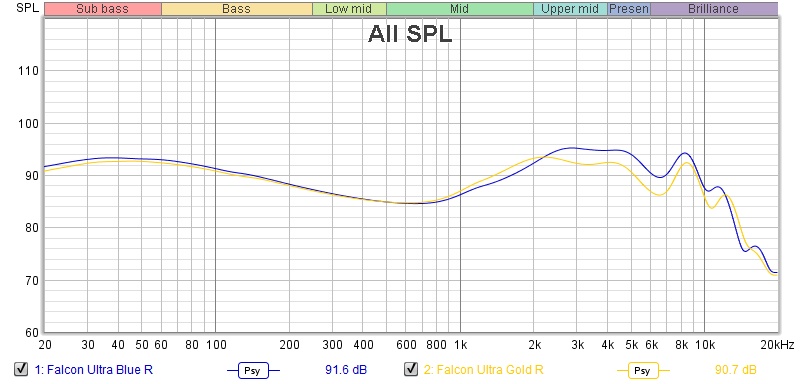
It is helpful to think of an IEM as a filter that highlights or subdues different parts of the incoming audio signal. This effect can be measured objectively by the squiggly lines above, called Frequency Response (FR) graphs, which measure how loud an IEM is at different frequencies from 20Hz (bass) to 20kHz (upper treble). Subjectivity is how your ears and brain interpret the effect of that filter on your music and decide whether it is “enjoyable.” There are some “rules of thumb” when it comes to tonality, but most interesting IEMs usually bend the rules masterfully.
The Falcon Ultra offers two distinct sonic presentations, depending on the tuning nozzles. Dunu has taken an interesting approach to designing the nozzles by varying not only the dampening foams and stick-on filters but also the internal diameters and materials of the nozzles. Before delving into the individual nozzle effects, let’s discuss the overall tonality profile of the Falcon Ultra.

Regardless of the nozzle choice, the Falcon Ultra presents a familiar tonality commonly associated with “well-tuned” single dynamic driver IEMs available in the market. The tonality can be described as Harman-inspired, with a boosted lower-midrange and midbass. The boost in the upper midrange centred around 2kHz to 3kHz, compensates for the lack of natural ear canal resonance when using IEMs, resulting in increased clarity and the presence of voices in subjective listening. For instance, when I listen to” Jolene (feat. Dolly Parton)” by Pentatonix, Falcon Ultra makes all voices, especially Dolly Parton’s, pop out more from the background. Similarly, when I listen to” Livin’ On a Prayer” by Bon Jovi and” Beat It” by Michael Jackson, both singers sound very clear and easy to follow. The electric guitars in “G.O.A.T.” by Polyphia also pop out more, making it easier to follow and discern the texture and articulation.

At the same time, Falcon Ultra does not stick to Harman’s target to a T, which is good. Dunu boosts the lower midrange below 500Hz, creating about 3dB above neutral at 250Hz. This additional boost helps thicken the midrange’s body and note weight, countering the 12dB upper midrange boost. The result is a warm tonal tint to both male and female voices, though not overtly coloured, when I listen to” Jolene (feat. Dolly Parton)” by Pentatonix. I also found that the voices are not unnaturally imbalanced to the upper midrange. As a result, they don’t sound tinny, thin, or shouty.
In general, the midrange tuning of the Falcon Ultra is well-done, making it pleasant to listen to with a natural timbre characteristic of dynamic driver setups. The only time the midrange tonality may feel slightly peculiar is when listening to “Bach’s Violin Sonata No.1 in G Minor: Presto” by Kavakos, where I can hear the effect of the boosted upper midrange, Harman-style, and the additional warmth. The G string has extra oomph to it. At the same time, the E string and higher positions on A sound brighter. Depending on your preference, the contouring of the tonal balance might or might not be offensive.
Personally, I prefer a ruler-flat midrange from 250Hz to 1000Hz, and then adding the “warmth” but reducing the amount of upper midrange boost from 12dB to around 8 dB.

Moving on to the treble. Like most Harman-inspired IEMs, Falcon Ultra is easygoing and rolls off the treble gradually after the ear-gain peak at 2-3kHz. Subjectively, it means that cymbals and hi-hats exist but are not very highlighted or “sparkly” when I listen to” Livin’ On a Prayer” by Bon Jovi,” Beat It” by Michael Jackson, and “G.O.A.T.” by Polyphia. Interestingly, there seems to be a slight peak around 8-10kHz, as I sometimes hear sibilance and treble edges. Another interesting finding is the presence of the upper treble, meaning the treble extension of Falcon Ultra is quite good. For example, when I listened to “Bach’s Violin Sonata No.1 in G Minor: Presto” by Kavakos, I was surprised to find that I could easily hear the reverb trail created by the recording hall at the end of violin notes. This reverb is not exaggerated like some BA sets tuned to impress, but I’m surprised to find it so prominent.
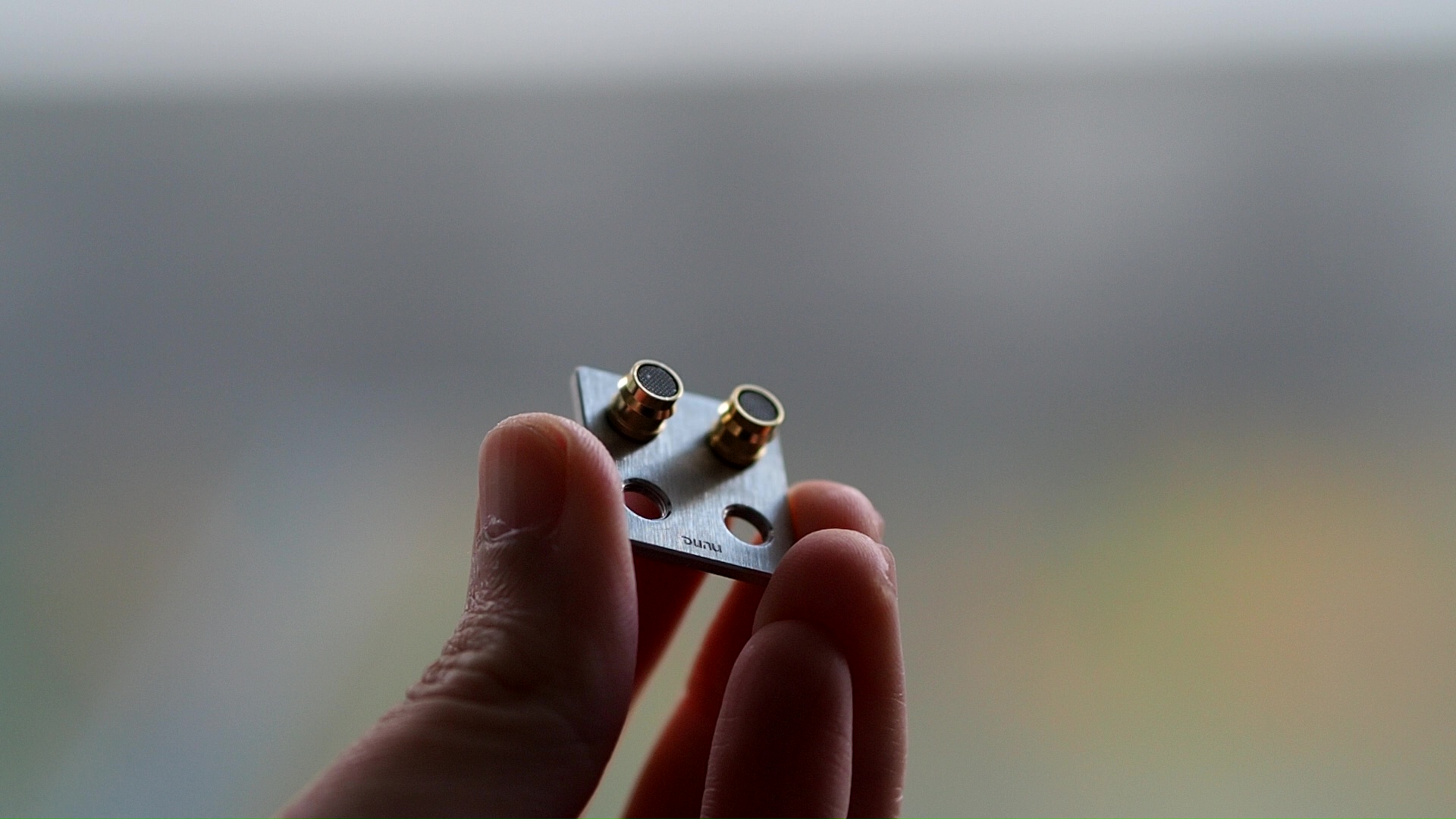
Before moving on to bass and dynamic, let’s talk about the effect of the nozzles. The default blue nozzle is made of the same stainless steel as the earpieces. It has a large diameter and internal dampening foams. Dunu describes the sound profile of this nozzle as “transparent and clean, quick response.” I say they are spot on. Falcon Ultra sounds crisp, clean, spacious, and dynamic in this configuration, though it does not sound razor sharp and thin like some multi-BA configurations.
The gold nozzle is made of brass. It has a smaller diameter and no internal dampening foams. Quite an interesting choice. Dunu describes the sonic profile of this nozzle as “rich and soft, charming vocals, smoother sound.” Again, I say that they are spot on. The golden nozzle pushes Falcon Ultra further to a warm, gooey tonality. The perceived dynamic is reduced, and the midrange becomes dense and less open. At the same time, the random sharp edges of the upper midrange and treble are mostly removed. Based on the impressions that I read, I guess that the gold nozzle sounds closer to the previous version, the Falcon Pro.
Bass and Dynamic
A good pair of IEMs/earbuds/headphones should be able to convey, even emphasise, the sense of rhythm and the ebbs and flows of music. In general, this energy requires IEMs to be able to convey rapid volume swings on the downbeat of an orchestra or the leading edge of bass note. It also requires tactile physical sensation of the bass, and the sense of rumble and texture accompanying the bass drops. An IEM can have loud bass, but still fail to convey energy should it lack other features above.
Unlike other single DD IEMs from Dunu, like the Titan S, at the heart of the Falcon Ultra is the proprietary ECLIPSE driver technology that debuted in the flagship Dunu Luna. This driver is rather neat. It has a full-metal W-shaped diaphragm that is glued on a flexible surround. The magnet driving this diaphragm is powerful. You can use one earpiece to push the other around with just the magnetic force, though I can’t get the earpieces to stick together like the Zen Pro.
What’s so special about the ECLIPSE drivers? Well, one of the noticeable aspects is the dynamic. And no, I’m not talking purely about the amount of bass. An IEM can have a lot of bass presence and still sound muddy, bloated, or cloudy without clear and fast bass “slams.” One of the noticeable features of the Zen Pro, the previous IEM with ECLIPSE drivers that I tried, was the sense of dynamic as if the bass “slams” you in quick and large waves. It feels fast, thumpy, and energetic.

Does Falcon Ultra capture that “slam”? To a certain degree, yes. When I listen to” Battle Bar” by Yuki Hayashi, my test track for bass rendering, I find that bass attacks feel natural. The leading edge of the bass note is clean but does not sound razor sharp like some well-implemented BA drivers (or even dual DD woofers). At the same time, There is a sense of texture in the decay end of bass notes. In other words, drums and bass guitar decay feels like a “brmmmm” rather than an overly smoothened “umm umm” sound. At the same time, the texture is not exaggerated to make the bass feel “dry” like the approach taken by some BA sets.
When I listen to my key test track for dynamic “Let the Battles Begin!” by Square Enix Music & Nobuo Uematsu, I found that Falcon Ultra can reproduce the dynamic swings or slams of the orchestra on the downbeats, creating a sense of tempo and impact, thus successfully convey the sense of urgency of this recording. Similarly, Falcon Ultra does a good job reproducing the slams by drums and the bass guitar in “G.O.A.T.” by Polyphia. “Livin’ On a Prayer” by Bon Jovi and “Beat It” by Michael Jackson feel energetic and dynamic, with a clear sense of beat and rhythm. Falcon Ultra also does a decent job with most tracks from Two Steps From Hell.
The granularity of the dynamic variation of Falcon Ultra is also excellent. For instance, it can recreate the ebbs and flows that convey the magnetic feeling of “Bach’s Violin Sonata No.1 in G Minor: Presto” by Kavakos.

At the same time, I wish that Falcon Ultra’s dynamic is even more exaggerated than just “naturally good”. The Falcon Ultra does not invoke the same “wow” that I had with the dynamic of Zen Pro. Of course, Dunu might need to leave something on the table for “Zen Ultra” or whatever the next revision of the Zen Pro is, and maybe crazy dynamic slam was never the design goal of Falcon Ultra. But I wish the “X-factor” is here to highlight Falcon Ultra further.
Soundstage Imaging

Stereo imaging or “soundstage” is a psychoacoustic illusion that different recording elements appear at various locations inside and around your head. Your brain creates based on the cues in the recording, which are enhanced or diminished by your IEMs, your DAC, and your amplifier. Some IEMs present a wide but flat soundstage. Some present a “3D” soundstage with layering, depth, and height. In rare cases, with some specific songs, some IEMs can trick you into thinking that the sound comes from the environment (a.k.a., “holographic”)
The soundstage imaging of Falcon Ultra is adequate, even good in the grand scheme, but it does not push the boundary of the IEM form factor. The centre of the stage where voices in songs such as “Jolene (feat. Dolly Parton)” by Pentatonix exist is mostly inside my head, behind my ears. The width of the stage can sometimes expand beyond the earpieces, such as the female voices on the sides of the scene in the song Jolene. Falcon Ultra can also convey the sense of height. For instance, some voices of Pentatonix in Jolene seem to float higher on the stage. This illusion might be attributed to the slight emphasis at 8-10kHz.
The bright spots of the stereo imaging performance of Falcon Ultra are the accuracy of instrument placement and the sense of depth. For example, in “G.O.A.T.” by Polyphia, I found no noticeable gap on the stage; the stage seems to wrap around the head at some parts of the music. There is a clear separation between the foreground inside the head and the background that appears to come from a distance, sometimes as if it comes from the surrounding environment. Falcon Ultra does not present the soundstage like a flat plane or an unrefined blob of sound in the middle, but with a decent sense of layering of instruments from closer to further away, despite placing most of the actions of the stage within the listener’s head.

It should be noted that Falcon Ultra does not have laser-sharp separation and layering like some multi-BA IEM sets. For example, when I listen to” Livin’ On a Prayer” by Bon Jovi and” Beat It” by Michael Jackson, I find that Everything is more blended without clear “air” to separate them. Luckily, the presentation does not sound mushy because the leading edge of the notes is decently well-defined.

The sense of ambience or “holography” of the soundstage of Falcon Ultra is rather good but not outstanding. As I mentioned, this IEM can convey the reverb created by the recording hall surprisingly well for a single DD IEM. What is missing when I swap from Falcon Ultra to other IEMs with top-notch or “holographic” imaging is how this reverb is shaped. For example, when I listen to “Bach’s Violin Sonata No.1 in G Minor: Presto” by Kavakos With Falcon Ultra, I can hear some depth, like the violin sitting in front of the reverb sound, but the reverb does not sound like an enveloping dome around my head to convey the sense of sitting in the environment like, say, MEST III or U12T.
Soundstage imaging with games (CS GO Gameplay by Throneful) The imaging advantage of Falcon Ultra does translate to a good gaming experience. Gunshots and footsteps sound slightly around the head rather than strictly within the head. The soundstage feels rounded. The positioning of sound in terms of direction is also good. The sense of distance is also adequate, though not “holographic”. If you have more skill in FPS than I do, you might be able to use these IEMs well.
Resolution

Resolution is a fascinating subject due to the difficulty of pinning down what it really is. To me, “resolution” can be broken down into three components: (1) Sharpness, incisiveness, or “definition” of note attacks (see the figure above). (2) The separation of instruments and vocals, especially when they overlap on the soundstage. (3) The texture and details in the decay side of the notes. The first two give music clarity and make it easy to track individual elements of a mix. The last provides music details and nuances. Smooth and well extended treble response plays a crucial role.
The resolution of Falcon Ultra is, again, quite good for a single DD. The overall definition and separation of instruments and vocals pleasantly surprised me. When I listened to ”Jolene (feat. Dolly Parton)” by Pentatonix, I could follow individual voices with not much effort. The smearing is surprisingly minimal. I’m particularly impressed by the definition of the female vocal on the far right of the stage. When you swap from the blue to the gold nozzle, the separation and definition are slightly reduced for a more gooey, comfortable listening experience. I prefer the blue nozzles.

The detail retrieval of Falcon Ultra is only okay. It narrowly avoids the perception of being overly smooth and lacking texture. For example, when I pay careful attention to the violin of Kavakos in Bach’s Violin Sonata No.1 in G Minor, I can discern some major details, like the breath and the articulation of the bow. However, it does not dig deep into the micro details and nuances of the violin notes themselves. Since most IEM does not do micro details well, the level of nuances and texture of Falcon Ultra would be sufficient in most situations and contexts.
Comparisons

Vs JD7: Frequent readers of my review would foresee this comparison, as FiiO JD7 has been one of my favourites in the single DD, budger-friendly IEM category. It has decent technical performance for a single DD and an adjusted Harman tuning that is pleasant and correct.
How does JD7 fare against Falcon Ultra? First of all, tonality. JD7 sounds very close to Falcon Ultra with the stock nozzle. The technical performance is where Falcon Ultra pulls ahead. When I listen to my familiar test track, “Jolene (feat. Dolly Parton)” by Pentatonix, I found that JD7 is more smeary than Falcon Ultra. In other words, it is more “effortless” for me to separate and follow individual voices with Falcon Ultra because everything is more sharply defined.
The sharp contrast between the two IEMs comes when I listen to the first drums around 0:30 of Victory by Two Steps From Hell. The Falcon Ultra simply convey more sense of energy with every drum hit. It’s not that the bass is louder, but the sense of “slam”, the urgency of each drum hit, is just more palpable.
Rating
 Tonality: 3/5.
Tonality: 3/5.
 Soundstage Imaging: 3/5
Soundstage Imaging: 3/5
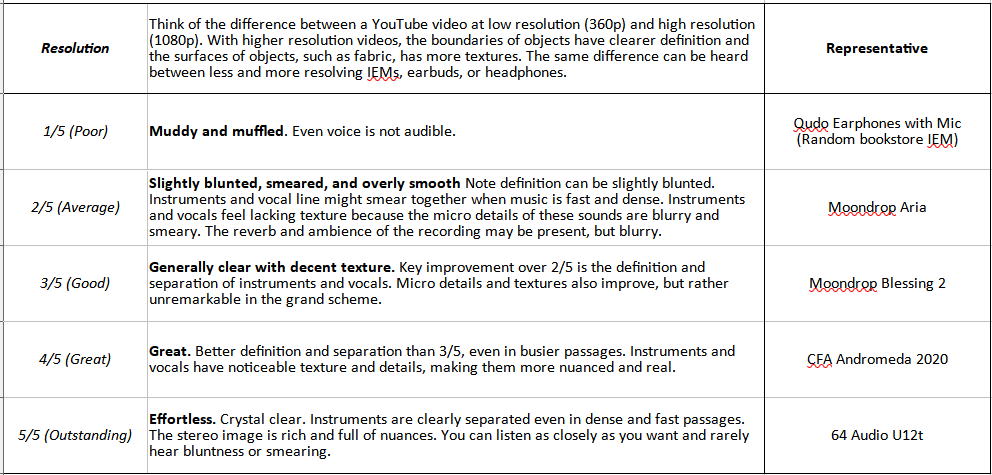 Resolution: 3/5
Resolution: 3/5
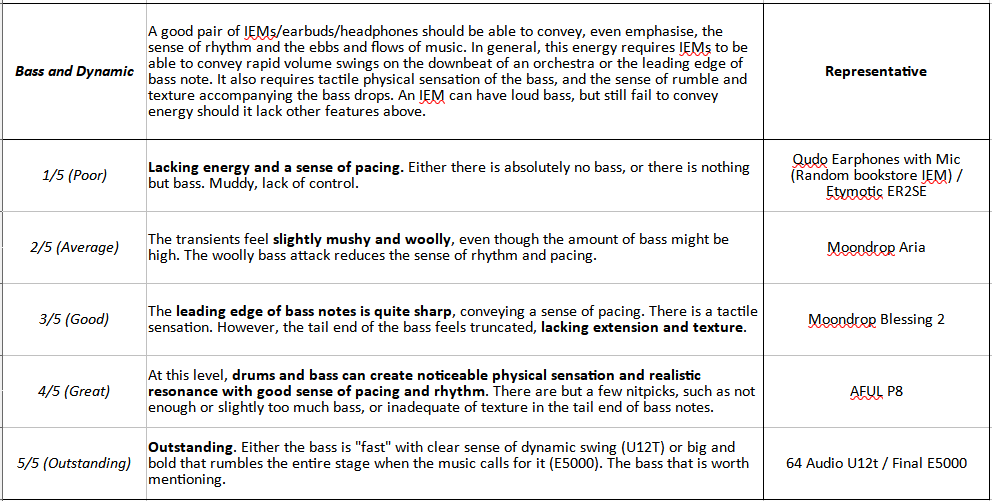 Bass and Dynamic: 4/5
Bass and Dynamic: 4/5
My Take
I’ll keep it simple: I like Falcon Ultra. Dunu took the ECLIPSE drivers and crafted an organic sound rather than trying too hard to make them sound like laser sharp tribrid IEMs. At the same time, the technical performance of Falcon Ultra shows a clear step up from the single DD of the yesteryears or even the current flavour-of-the-month single DDs. The result is an IEM that sounds right, showcasing the naturalness and dynamic of a single DD without suffering much of the limitations of this driver configuration, such as peaky lower treble and rolled-off upper treble.
I believe that $240 is already a lot of money for an IEM; thus, the product should feel like a pricy product. Despite having a smaller cardboard box and a bit less sophisticated interchangeable plug system, Falcon Ultra does feel like a pricy and well-built product, so thumbs up from me on this front. I might be an odd one here, but I don’t believe IEMs with the single dynamic driver has any reason to pass a $1000 or even a $500 price tag unless it has been hyped to the moon (or black hole) and back. So, double thumps up for Dunu to keep the price tag sane (though I suspect a “Zen Ultra” somewhere in the Dunu R&D lab is getting ready to push the price bracket).
Absolute Sonic Quality Rating: 3.5 (Good)
Bias Score: 4/5 (I’m happy to add this IEM to my rotation)
